
|
Note ye ed's email address: stevebryant99@gmail.com. |

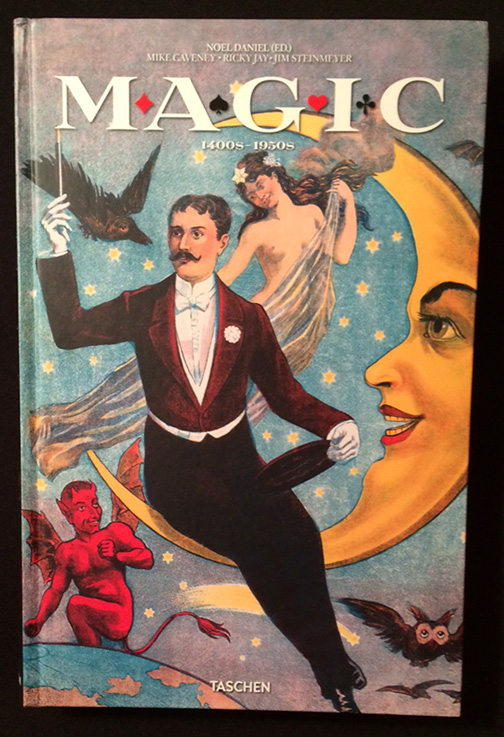
Book of the month?
|
Last month's black and white Halloween issue covered the Genii convention, the Illusionists in Indiana, and a Bill Neff faint check. |
November 2015 The term genius gets tossed about loosely in magic, which is after all a branch of show business. Even so, taking a look at the authors discussed this month, we seem to have an embarrassment of riches, material from some of the brightest guys around, in or out of magic. It has been daunting to try to absorb their thinking in a few short weeks. It is going to be even more daunting to try to find bookshelf space for their latest products. Honey, let's go house hunting! Meanwhile, I urge you to click on some of the links in the text. The bonus information is interesting. Hey, I've even added a Twitter link down at the bottom. Happy Thanksgiving to all, and go easy on the gravy. |
|
|
Who says the publication of magic books is on the wane? What follows this month is far more than any magician should attempt to read, and the Tenyo and Lewis Jones books I ordered are still en route. As to those that arrived ... PAST THANKS --There was much to be thankful for in the Thanksgiving season of 2009, most notably the mammoth sixteen-pound edition of Magic 1400s-1950s, from Taschen. The original was over 17 inches tall and ran to 650 pages, in three languages, and it covered six centuries of magic as played out through ad art and photos. It was a magnificent job or editing and scholarship by Noel Daniel, Ricky Jay, Mike Caveney, and Jim Steinmeyer, with an original retail asking price of $200.  The "junior" edition abounds with exciting posters and photos. So why mention it again? Taschen often re-releases its works in slightly different formats (softcover vs. hard, different sizes and shapes, calendar vs. book, postcards vs. book, etc.). Sharp-eyed shoppers on the Genii forum recently noticed that Barnes and Noble had a version listed at $19.98 on sale for $18. It's in my hands and lovely, an English-only version that runs 385 pages, at 13.5 by 8.75 inches, all of which makes it a far more accessible reading experience and easier on the lap. As of publication, I couldn't find this version on the B&N site by entering the title, but found it finally by entering Caveney. (Thanks, Bill Mullins.) STILL WILD ABOUT HARRY -- Most of us, if we are ever lucky enough to face the prospect of turning 90, can expect to be drooling into our pudding at the home. Not Harry Lorayne! Harry is still churning out magic books, books of card tricks a young magician would be proud of, with more on the way. His latest is Jaw Droppers!, advertised as 63 effects and routines with over 210 photos, all in Harry's unique voice. As Bob Farmer wrote of Harry's Ten Card Poker Deal (in The Bammo Ten Card Deal Dossier), "Harry Lorayne's voice is so singular, his enthusiasm is so contagious, his routine so good and so important, his comments and observations so lined with gold, only a fool would think of changing any word he has written." These endorsements apply to all of Harry's books (I count 40 on magic alone), and I can think of few pleasures in magic greater than spending an afternoon with a new Harry Lorayne book and a deck of cards. 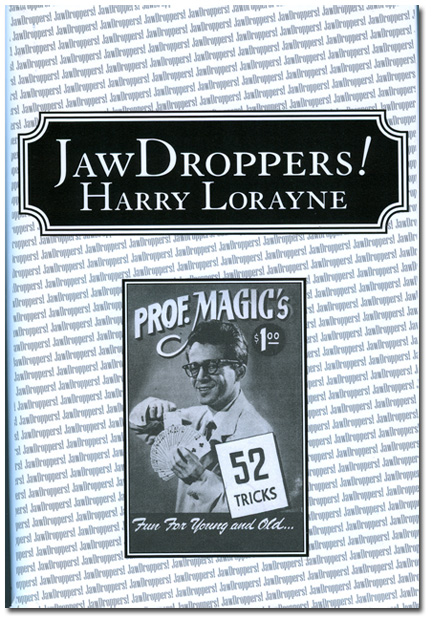 The Professor for six decades. As for the latest jaw droppers, Harry has not lost his touch for making strong card magic even more practical, more commercial. A few pieces that stand out ... Blown Further Away takes one of Juan Tamariz's most popular tricks, one which required a stack, and makes it completely impromptu. Harry cites this as a favorite of Steve Cohen. Thirteen Closer begins with the magical production, in order, of all the cards of a given suit. When the king turns out to be of a different suit, all the other cards change to the same suit as the maverick king. If you are not in love with this climax, then the original Thirteen is also a very strong sequence for Fusillade. For that, any time, any deck. Progressive Elevator begins with a single ace rising to the top, then two at a time, then three and four. Personally I would do the four via Flash Aces from Close-Up Card Magic. I've been doing that sequence since high school, which means I have been "with" Harry for part of six decades. Assembly Backfire is a progressive queen assembly routine with the surprise finish of the queens returning to their original piles. Very clever. Ten-Count Cut is sort of Cardistry for the rest of us. Three Steves is a nice extension of Steve Mayhew's Old Lazy Fat Guy Cull (from What Women Want). The usual high-quality hardback, 248 pages, lots of personal photos along with the illustrative photos, $78.90 postpaid (U.S.), direct from Harry at 48 Liberty Street Unit F, Newburyport MA 01950. BUT WAIT, THERE'S MORE -- When I ordered Jaw Droppers!, Harry offered me a great deal on some of his past books, so I picked up his autobiography, Before I Forget. It is currently my bedside reading, I am about two-thirds through it, and it's fascinating. Through osmosis from 40 card books over the years, I know a lot about Harry Lorayne, but there was way more that I didn't know, and it's fine, highly entertaining reading. But if you are already a fan of the best teacher in magic, you know that. UNDER HIS HAT -- I became a fan of Patrick G. Redford through a pair of his comics (Triangle and Square) and through a killer lecture given in Indianapolis. One of my favorite routines that I keep in practice is Spot Poker Tells, an impossible card location from a shuffled deck. His latest offering is Applesauce, a slim hardback (think the same scale as Aaron Fisher's The Paper Engine) of some 14 items. 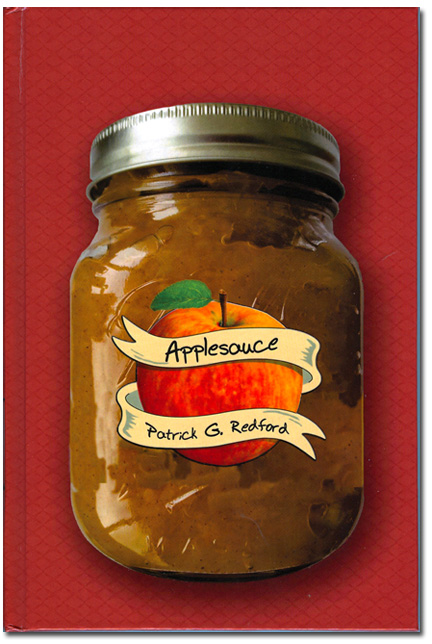 A jar full of card tricks. A few that jumped off the page: Spot Poker Tells is reprised from Square and a welcome player in any book of card tricks. It uses technology developed by Mike Powers and Simon Aronson, and the challenge to the magi is to remember three pieces of information none of which he should know. The spek is convinced that you determine the card via a sort of psychic poker tell. It's very effective. Applesauce (Any Thought of Card at Any Thought of Number) uses the same methodology as above but reduces the required info to two items. The spek supplies the third on his own. Of several variants offered, I prefer the one using Raahul's Ruse. Storm is an apparent rapidly memorized deck routine, but you need recall only two cards to pull it off. In actual effect, the spek names her card and you tell her its exact location along with the two cards that sandwich it. Additional subtleties make it seem as if you know all the cards. Advantageous lets you scan through a shuffled deck, write a prediction on a business card, and watch as the spek deals cards face up, stopping where she chooses. She stops at your prediction. Or close enough: you predict the 15th card, with a margin of error of 10 cards. Wipe-Out has a similar effect for the spectator (you write a prediction, she deals to the card you predicted) but uses a clever stack, wording, and something extra to make it happen. Satisfying! I miss the fun of the comic book format, but the material is as brilliant as usual. Hardback, 158 pages, $59. I bought mine from H&R Magic Books. |
|
|
STROKES OF GENIUS -- Robert Parrish's New Ways to Mystify, one of my top five favorite books of magic, opens with "The old-time magicians by no means confined their peculiar activities to the stage. They went around being magicians all of the time, and as a matter of fact some of their most charming tricks were performed in such unlikely places as in grocery stores, or at restaurant counters, or even on street corners. Alexander Hermann used to upset store clerks by finding gold coins within fresh eggs and alarm unsuspecting waiters by vanishing a glass of wine with a swift decisive toss. He did things like this anywhere, especially when newspapermen were around." 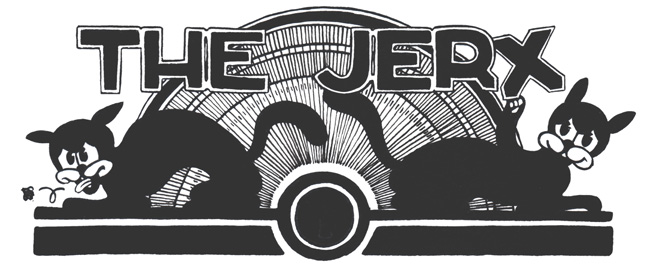 Looks like The Jinx, but think again. Perhaps no one is creating more mystifying magic for real-life situations than "Andy," the somewhat secretive author of the Jinx-like blog The Jerx, which you can read about here. I was recently turned on to Andy's blog by internet correspondent Joe McKay, who boldly asserts that Andy is the best thinker in magic. That was enough of an endorsement for me to sample Andy's (he says that isn't his real name, but for our purposes ...) prior posts, where I not only encountered unexpected brilliance, but had this huge smile on my face as I began reading the routines, for Andy thinks very funny when he is doing that thinking. Hard to say in only a few hours if Andy is the best thinker in magic, or even the best on this page (take another look at who I am discussing this month!), but he certainly belongs in the discussion. I should warn any namby-pambies that the humor is what I aways thought was erroneously called adult, and therefore you might be prone to actually laugh out loud, so be prepared to explain this to your life partner who might be in the same room. You would not want to explain a recent Dollar Bill to Impossible Location, but a Pregnancy Tester is something I might have tried, once upon a time. The logistics of being a fan of the blog are still a bit confusing to me. You can check the site out for free. A book is on the horizon, The Jerx Volume 1, pricey at $260, and you may not be lucky enough to obtain a copy if you don't pre-order. The most recent post about the book is here. If you want to merely (or also) contribute to the site, you can do so here. What? Money? Never heard of the guy? I hadn't either, until recently, and am now a fan. NEW DEALS -- You say that you bought Bob Farmer's The Bammo Ten Card Deal Dossier and you didn't think there could possibly be any more versions? (Wait! Time out. Last month I referred to the book and wrote "Blammo" instead of "Bammo," and no one noticed? If you catch me in a stupid misspelling, let me know, please.) Anyway, last month I mentioned purchasing Michael Weber's Ten at the Genii convention. Ten is a kit built around ten more versions of the Ten Card Poker Deal. You get a 60-page book and a box full of props that allow you do do some out of the box versions, including a two-phase scratch off card version, a ten-card deal that uses only five cards, an over-the-phone version, a fortune cookie version, and more, all leading up to the version in which I did not win $100, even though I held all the cards and could choose either hand. Michael asks that customers not discuss the routines, so I don't want to give specifics, but do want to endorse the product.  Ten Card Poker magic kit. I mention the product in this section because Michael proposes that you use the different approaches in layers, dealing Ten Card Poker to the same audience over time, some of the approaches arising organically from various (yet orchestrated) situations. It's a clever scheme for messing with someone's head. I think Michael sells stuff like this only one on one at conventions, so good luck to you. Keep an eye out. His peek wallet, Seer, was also way cool. |
|
|
THE PUZZLE KING -- Indiana University's Lilly Library, which I toured a year ago (See In the stacks), is home to Jerry Slocum's prodigious mechanical puzzle collection, with over 30,000 puzzles and 4000 puzzle-related books. The library periodically hosts special exhibitions, and the newest is devoted to Sam Loyd: Puzzle King, running from October 12-December 20. Born in 1841 in Philadelphia, Loyd soon become the problem editor for Chess Monthly (he was only sixteen) and began publishing puzzles of his own creation in 1868, with Trick Donkeys. Loyd first distributed his puzzles on trading cards and later via mass-circulation newspapers and magazines, where he often enjoyed full-page displays. This huge body of work found its way into Loyd's posthumous Cyclopedia of 5000 Puzzles, Tricks and Conundrums, hailed by Martin Gardner as "the largest, most exciting collection of puzzles ever assembled between the covers of one volume." Many of his published items are on display in the Lilly exhibition. 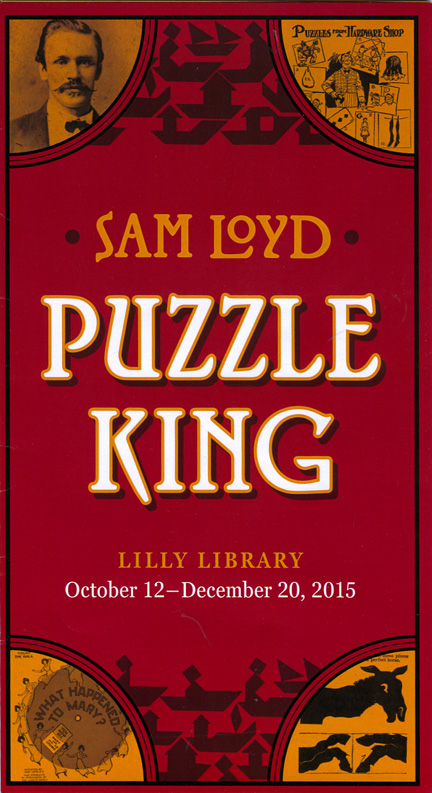 Puzzles that will stump you. The exhibition officially kicked off on November 5 with a talk on Loyd by Will Schortz. Mr. Schortz, an IU grad with a degree in Enigmatology, owns the world's largest puzzle library, with over 25,000 books and magazines dating to 1533. You might know him better as the crossword puzzle editor of The New York Times. Although some biography crept in, Mr. Schortz confined most of his talk to Loyd's most famous and clever puzzles (one still unsolved), and these clearly delighted him as they did the audience. It was (surprising to me) an older crowd, and I sat next to an ex-Lilly employee who told me about the time Ricky Jay did research at the Lilly on blow books, and that Ricky had delighted the staff with a demonstration of the books. The biographical element revealed that Loyd, as brilliant as he was, was also something of a scoundrel who would take credit for puzzles he had not created. He boldly claimed to have invented the game Parcheesi (it was played in India from the 4th century) and the 14/15 puzzle (tiles with digits that you m ove around in a little tray to get them in order). Despite the evidence to the contrary, many believed him, and most of his obituaries got it wrong. (The Encyclopedia Brittanica online still has it wrong.) Jerry Slocum, who was present to help field questions, gave a fascinating talk on this aspect of Loyd's career at the seventh Gathering for Gardner in 2006; you can find it online at Sam Loyd's Most successful Hoax. RECREATIONAL MAGIC -- According to the Don Albers interview with Martin Gardner, published in the College Mathematics Journal in 2005, Martin's father gave him a copy of Sam Loyd's 5000 Puzzles when Martin was a boy, and that sparked his interest in recreational math. (Later Martin would edit two of Loyd's books of mathematical puzzles for Dover.) If there had been no Sam Loyd, would we have had a Martin Gardner? 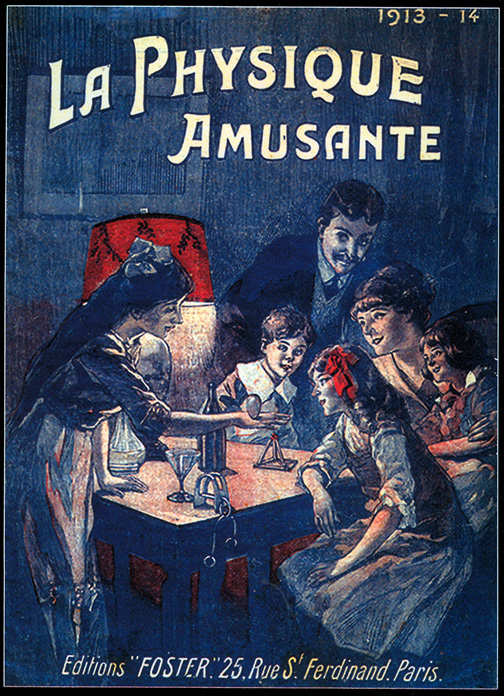 The mysterious back side of Impromptu. Certainly, if we had no Martin Gardner, we would not have had Impromptu, the massive tome that arrived this weekend from Todd Karr's Miracle Factory. Todd's books are among the handsomest of my collection, and Impromptu is no exception. Physically, it's 8 by 10 inches encompassing 904 pages (864 of which are numbered) in the usual classy Miracle Factory layout (most recently enjoyed in the Gaeton Bloom books). New to the layout: the frontal pages including the table of contents are highlighted with gold headings. Nice. Contents include a cover image by Steranko, a Foreword by Teller, a Preface by John Fisher, a 26-page history of Impromptu magic by Todd, the previously mentioned (22-page) interview with Don Albers, a section in color of Gardner trade cards (XL pages), the complete and reorganized Encyclopedia of Impromptu Magic (441 pages, with a new interview of Martin by Todd), 79 pages of Gardner's notes (3 by 5 notecards, handwritten, with an intro by Mark Setteducati), a chapter of 40 letters from Martin to various magicians, Martin's four monographs on magic with a one-page intro, 57 pages of planned revisions, photos of Martin at the Alice in Wonderland sculpture in Central Park, and a detailed index (that I have already used repeatedly; thanks!). For me, everything about this book is a win-win. I know there has been some grousing. But I didn't pre-order the book, so have not been waiting impatiently for its arrival. I overlooked the ads that promised inputs from Mac King and John Carney and Michael Weber. I find that to be okay too, for what we are left with is pure Gardner. I would not have been all that pleased if new material were added that Martin never saw, just as I never liked the idea of tacking new volumes to the Tarbell series that Tarbell never saw. (That said, I grasp that Mac's Fork in the Eye might have been one of the most popular entries.) What we do get is wonderful. The Albers entry was the nicest surprise. Just as with the Harry Lorayne bio, there was so much about the subject that was unknown to me, plenty of surprises. I'll mention three. 1. Martin's only stint as a professional magician was demonstrating A.C. Gilbert Mysto Magic sets at Marshall Fields during a Chicago Christmas season. (Love to have a video of that!) 2. Martin served aboard a Destroyer Escort that captured a German submarine during WWII. 3. Martin was Humpty Dumpty, Jr., in Humpty Dumpty's magazine! Writing as Humpty, Jr., son of the famous egg, Martin wrote 80 short stories along with poems of advice from father to son. I remember the magazine and would love to have copies of it. Eventually, Martin moved directly from Humpty Dumpty's to Scientific American. What a transition! (Note: That journalistic transition got me wondering about the timing of his magic contributions. As far as publication dates, Martin's contributions to Hugard's ran from October 1948 through April 1958; his column began in Scientific American in January 1957. I don't know when the columns were actually written.) Similar surprises await you in the interview. As to the main content, some have groused that they are getting "only" the Encyclopedia that had been published 1978 by Magic, Inc. I didn't own that volume, so that complaint doesn't apply to me. (I do possess the bound Hugard's, so was familiar with the content, but that's a different situation.) I would still want this book; in addition to all the supplementary material, this is an amazingly handsome version with reorganized content, a delight to peruse. I know that some magicians are wrapping the entire volume up to be opened at Christmas. I plan to compromise and not dig too deeply into this heart of the book until the holidays. Speaking of the content, one entry is "Sam Loyd's Pencil in Buttonhole." Hmm, did he really invent this classic? (This was the first "impromptu" magic trick I ever saw, at a resort in the Ozarks, on the only vacation my family ever took.) Yes, I know the note cards in Martin's handwriting are difficult to read. Nevertheless, they provide a picture perfect look at how Martin worked, and there is gold there if you look for it. I quickly stumbled upon a great enhancement to the Newspaper Strip Force, page 627. The letters and the planned revisions are far more readable and similarly offer a perfect view of how Martin became Martin. Available from The Miracle Factory, 904 pp hardbound, over 1700 tricks and stunts, over 2600 illustrations including 900 line drawings, $150. A must buy for anyone interested in Martin Gardner and his contributions to magic. You have to step back and think, what a nice world we live in that it contained a Martin Gardner. |
 First family vacation, when Pencil in Buttonhole lured me to magic.
Christmas is coming. Order Lucas Mackenzie and The London Midnight Ghost Show today.
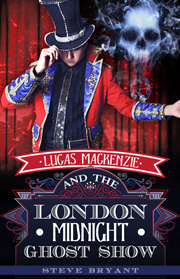
Follow us on Twitter. Little Egypt Magic is the erratically updated web site of Steve Bryant, spawned (the site, not Steve) by a former internet magazine known as The Little Egypt Gazette/for magicians only. Steve Bryant is an obscure magician and writer who generates this site from an iMac in Bloomington, Indiana. He used to frequently journey to and perform magic in Little Egypt, the local name for extreme southern Illinois, where the towns bear such names as Cairo, Thebes, and Karnak. Past issues of this web site: Index to Past Issues Notice: Any limited use of copyrighted images or quoted text is considered fair use, usually to review whatever product or event that is under discussion. If you object to use of any material, please get in touch and it will be cheerfully removed. |
A JSB Creations product
Copyright© 2015 by Steve Bryant